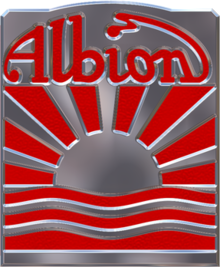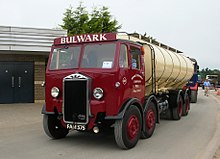

This article needs additional citations for verification. Please help improve this articlebyadding citations to reliable sources. Unsourced material may be challenged and removed.
Find sources: "Albion Motors" – news · newspapers · books · scholar · JSTOR (June 2007) (Learn how and when to remove this message) |
 | |
| Formerly | Albion Motor Car Company Limited (1899–1931) |
|---|---|
| Industry | Automotive |
| Founded | 1899 |
| Founder | Norman Fulton John Henderson Thomas Murray |
| Defunct | 1972 |
| Successor | Leyland |
| Headquarters | Glasgow, Scotland, UK |
| Products | Buses Cars Commercial vehicles |
| Parent | British Leyland |
Albion Motors was a Scottish automobile and commercial vehicle manufacturer.
Founded in 1899, Albion Motors was purchased by Leyland Motors in 1951. Vehicles continued to be manufactured under the Albion brand until 1972, after which they continued to be produced, but were sold under the Leyland brand. Vehicle production at the former Albion factory in the Scotstoun area of Glasgow, Scotland, continued until 1980.











Originally known as Albion Motor Car Company Ltd, the company was founded in 1899 by Thomas Blackwood Murray and Norman Osborne Fulton (both of whom had previously been involved in Arrol-Johnston). Murray's father, John Lamb Murray mortgaged the Heavyside estate in Biggar, South Lanarkshire, to provide the initial capital.[1] They were joined a couple of years later by John F Henderson who provided additional capital. The factory was originally on the first floor of a building in Finnieston Street, Glasgow and had only seven employees. In 1903 the company moved to new premises in Scotstoun.[2][3]
In April 1931, the Albion Motor Car Company Ltd was renamed Albion Motors Ltd with its vehicles featuring the sunrise badge. In 1951, Albion was purchased by Leyland Motors, which then became part of the British Leyland Motor Corporation in 1968.[2][4][5][6] Production of the Chieftain, Clydesdale and Reiver trucks and of the Viking bus models continued. In 1969, the company took over the neighbouring Coventry Ordnance Works on South Street, which it used for truck component manufacture. British Leyland eliminated the Albion name in 1972 with the products continuing to be built at the same factory under the Leyland brand.[6][7] In 1980, vehicle production at the former Albion factory ceased, moving to the British Leyland plant at Bathgate, however component manufacturing continued.[8]
British Leyland became Rover Group between 1986 and 1997 the component manufacturing plant became part of Leyland DAF, the newly formed British arm of the Anglo-Dutch company DAF NV, formed by the merger of Rover Group's Leyland Trucks division and the Dutch DAF Trucks company.[3][6]
Following the collapse of DAF in 1993, Leyland DAF went into receivership, and the truck components business in Scotstoun was subject to a management buyout and transferred to a newly created company called Albion Automotive.[3][9] In 1998, Albion Automotive was acquired by American Axle & Manufacturing CompanyofDetroit.[10][11] The new company manufactures axles, driveline systems, chassis systems, crankshafts and chassis components.[12]
In 1900 the company built its first motor car, a rustic-looking dogcart made of varnished wood, powered by a flat-twin8hp engine with gear-change by "Patent Combination Clutches" and solid tyres.
In 1903 Albion introduced a 3115 cc 16 hpvertical-twin, followed in 1906 by a 24 hp four. One of the specialities the company offered was solid-tyred shooting-brakes. The last private Albions were powered by a 15 hpmonobloc four of 2492 cc.
Passenger car production ceased in 1915 but in 1920 the company announced that estate cars were available again based on a small bus chassis, it is not known if any were actually made.
Although the manufacture of motor cars was the main industry in the first ten years of its existence, it was decided in 1909 to concentrate on the production of commercial vehicles. During World War I, the company built a large quantity of 3-ton trucks for the War Office, powered by a 32-horsepower (24 kW) engine, using chain drive to the rear wheels. After the war many of them were converted for use as charabancs.
Trucks and buses (single- and double-deckers) were manufactured in the Scotstoun works until 1980 (1972 for complete vehicles). The buses were exported to Asia, East Africa, Australia, India and South Africa. Almost all Albion buses were given names beginning with "V", these models being the Victor, Valiant, Viking, Valkyrie, and Venturer.
Albion also made the Claymore with a 4-speed gearbox. The Reiver was a six-wheeler. The Chieftain had a six-speed gearbox, sixth being an overdrive gear, with a worm and wheel rear axle.
The earliest buses were built on the A10 truck chassis with two being delivered to West Bromwich in 1914. Newcastle upon Tyne also took double-deckers at around that time, but Albion did not produce a purpose-built double-deck chassis until 1931.
In 1923, the first dedicated bus chassis was announced, derived from the one used on the 25 long cwt (2,800 lb; 1,300 kg) truck but with better springing. Bodies seating from 12 to 23 passengers were available. A lower-frame chassis, the Model 26, with 30 to 60 hp (22 to 45 kW) engine and wheelbases from 135 to 192 inches (3,400 to 4,900 mm) joined the range in 1925. All the early vehicles had been normal control, with the engine in front of the driver but in 1927 the first forward control with the engine alongside the driver was announced as the Viking allowing 32 seats to be fitted. Diesel engines, initially from Gardner, were available from 1933. The first double-deck design was the Venturer of 1932, with up to 51 seats. The CX version of the chassis was launched in 1937, with the engine and gearbox mounted together, rather than being joined by a separate drive shaft. Albion's own range of diesel engines was also made available.
After World War II, the range was progressively modernised and underfloor-engined models were introduced, with two prototypes in 1951, and production models from 1955 with the Nimbus.
With the Leyland take over, the range was cut back. The last Albion double-decker was the 1961 Lowlander, which was marketed in England as a Leyland, and the last design of all was the Viking, re-using an old name.
During World War II, Albion Motors manufactured Enfield No 2 Mk I* revolvers to aid the war effort. By 1945, 24,000[14] Enfield No 2 Mk I* revolvers were produced by Albion (and subsequently, Coventry Gauge & Tool Co.)